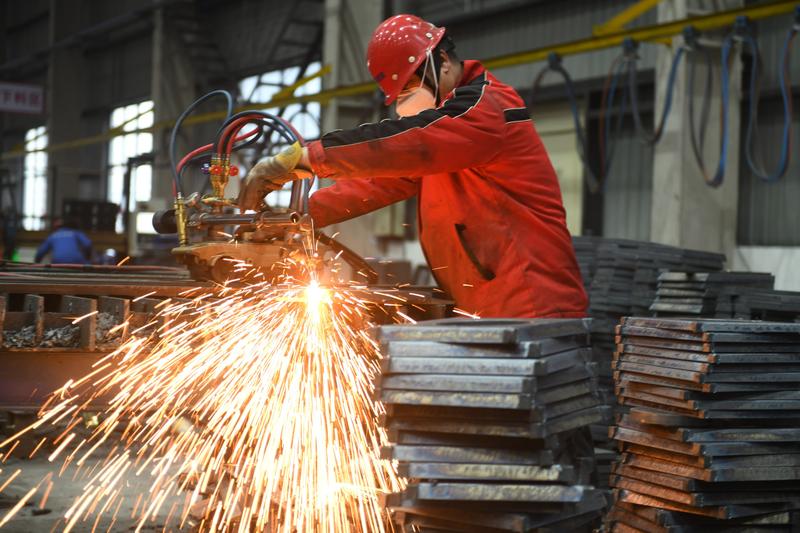 A worker carries out computer numeral control cutting operations at a steel structure processing workshop in an industrial park in Fuyang, Anhui province, on Feb 18. (WANG BIAO / FOR CHINA DAILY)
A worker carries out computer numeral control cutting operations at a steel structure processing workshop in an industrial park in Fuyang, Anhui province, on Feb 18. (WANG BIAO / FOR CHINA DAILY)
When news came in late April that China Baowu Steel Group, the nation's largest steelmaker, was taking majority control of Xinyu Iron & Steel Group, a steel company in Xinyu, Jiangxi province, perhaps very few felt surprised despite the move happening at a time when steel demand and production in China seemed to have been dampened by various factors, including COVID-19.
Despite a dip in both demand and output in the first quarter, China's steel industry is still expected to see gradual rebounds to register stable operations as new policy measures are adopted to ensure steady economic growth, industry experts said.
They also said the industry has accelerated structural upgrades to pursue greener growth pathways.
According to the China Iron and Steel Association, China's steel consumption dropped 5 percent on a yearly basis in the first three months.
The National Bureau of Statistics said pig iron output in China totaled 201 million metric tons in the first quarter, down 11 percent from a year ago. Crude steel production was 243 million tons, declining 10.5 percent on a yearly basis.
Qu Xiuli, deputy chairwoman of the CISA, the top steel industry association in China, said the industry is expected to have a better performance as the overall Chinese economy expands and policy measures ensuring stable growth take better effect.
She attributed the fall in demand mainly to pandemic-induced disruptions to construction and manufacturing activities. The output plunge was mainly due to factors including a production halt caused by pandemic-related shutdowns and output cuts during the heating season for environmental protection. The factors also include increased difficulties in raw material transportation, contract execution and surging production costs, she said.
In the first quarter, steel consumed by the construction and manufacturing sectors declined by 7 percent and 2 percent year-on-year, respectively, according to the CISA.
"The industry achieved a balance between supply and demand in the first quarter. Although steel enterprises saw a year-on-year decrease in profitability during the period, they still posted month-on-month profit growth," said Qu.
Enterprises have also been upgrading their product portfolios to better meet high-end demand while strengthening efforts on environmental protection and low-carbon development to achieve a significant reduction in energy consumption, she added.
Shi Hongwei, deputy secretary-general of the association, said the demand curbed by the pandemic is only postponed rather than evaporated, and a demand recovery is likely to be seen in the second half.
"As the pandemic is getting controlled, and normal operations of industrial and supply chains are gradually restored, we have confidence in a demand surge in the second half of the year," Shi said, predicting overall steel output and consumption in 2022 will be of a similar level to that of last year.
According to the Beijing Lange Steel Information Research Center, China's social steel inventory, or those stored in steel trading and distribution companies, had dropped week-on-week for eight consecutive weeks as of April 29.
On that day, the index of social steel inventory stood at 157.1, declining 2.65 percent from a week earlier. The figure was also 7.32 percent lower than a month ago, although it grew 2.16 percent year-on-year.
Chen Kexin, chief analyst at the research center, said more measures are expected to be launched by authorities to facilitate economic growth and consumption rebounds, as the Political Bureau of the Communist Party of China Central Committee further stressed the importance of economic stability at recent meetings.
That will inject more confidence into the steel market, Chen said. Predicting more spending on transportation, energy and water infrastructure, he said the healthy development of the real estate sector will beef up steel demand and provide further impetus for stable operations of the steel industry.
China's goal to curb crude steel output growth is appreciated by professionals in the industry because cutting excessive output is conducive to stabilizing steel market expectations and will help upstream and downstream enterprises maintain steady operations. The nation is fully capable of achieving its goal for crude steel output cuts this year, said Lu Zhaoming, deputy secretary-general of the CISA.
China Baowu Steel Group plans to reduce its average carbon intensity by 30 percent from 2020 to 1.3 tons per ton of steel produced by 2035 before achieving carbon neutrality by 2050.To get there, the company will adopt various measures, including the use of hydrogen-enriched carbon recycling blast furnaces.


